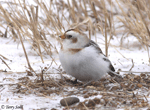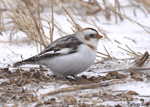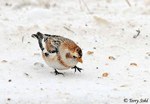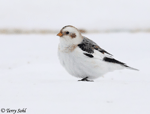| Length: 6.25 to 7.25 inches | Wingspan: 12 to 13 inches | Seasonality: Winter |
| ID Keys: Pale brown and white in winter (in South Dakota), with bold white wing patch | ||
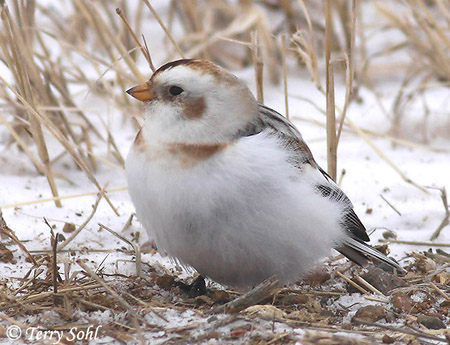 The Snow Bunting is a
winter visitor to South Dakota. They are most easily observed after a
fresh snowfall, where they can often be found foraging along the edges of roads,
often in mixed flocks with Horned Larks and
Lapland Longspurs. Starkly white with black patches in the
summer (males), they become duller with pale brown and white coloring during
their winter visits to the state. Strongly preferring their summer Arctic
habitat, they are generally very late to arrive in the winter, and very early to
leave in the spring. Males usually leave a month before the females in the
spring to establish breeding territories, arriving on the breeding grounds when
it's often still extremely cold.
The Snow Bunting is a
winter visitor to South Dakota. They are most easily observed after a
fresh snowfall, where they can often be found foraging along the edges of roads,
often in mixed flocks with Horned Larks and
Lapland Longspurs. Starkly white with black patches in the
summer (males), they become duller with pale brown and white coloring during
their winter visits to the state. Strongly preferring their summer Arctic
habitat, they are generally very late to arrive in the winter, and very early to
leave in the spring. Males usually leave a month before the females in the
spring to establish breeding territories, arriving on the breeding grounds when
it's often still extremely cold.
Habitat: Summer habitat is the northern Arctic tundra, preferably in areas with rocky outcrops. In winter, they can be found in a wide variety of open habitats, including farmland, shortgrass prairie, and shorelines.
Diet: Primarily seeds and insects, with seeds making up a large portion of the diet in all seasons. Will also occasionally feed on leaves and buds, and on small crustaceans and mollusks in coastal areas.
Behavior: Forages by walking on the ground.
Breeding: Non-breeder in South Dakota
Song: Repeated series of strong high trilling notes.
Migration: Summers in Arctic. Winters in much of Canada and the northern half of the U.S.
Interactive eBird Map: Click here to access an interactive eBird map of Snow Bunting sightings
Similar Species: McKay's Bunting (not found in South Dakota).
Conservation Status: Breeding range is generally beyond most human influence. They are found across a broad geographic area, and are common in parts of their range. Their numbers are in decline, but not at a level that would threaten overall populations. The IUCN considers the Snow Bunting to be a species of "Least Concern".
Further Information: 1) USGS Patuxent Bird Identification InfoCenter, Snow Bunting
3) Audubon Guide - Snow Bunting
Photo Information: January 19th, 2009 - Minnehaha County, South Dakota - Terry Sohl
Additional Photos: Click on the image chips or text links below for additional, higher-resolution Snow Bunting photos.
| Click on the map below for a higher-resolution view |
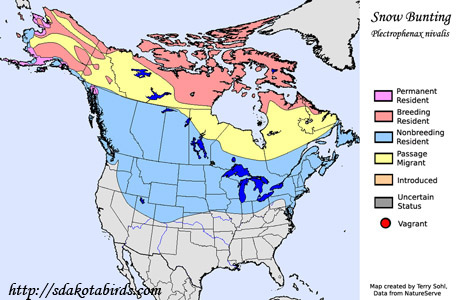 |
| South Dakota Status: Winter status irregular, although they can be quite common locally. More common in the eastern part of the state than the west. |
Additional Snow Bunting Photos
Click for a higher-resolution version of these photos
